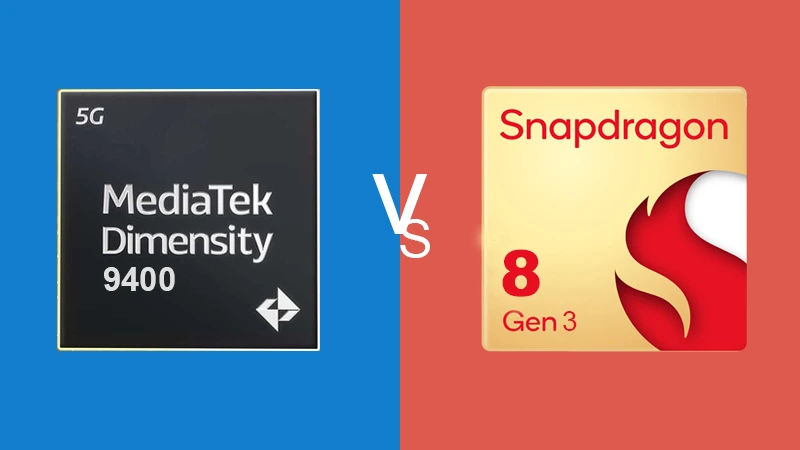Among the contenders for the crown are MediaTek with its Dimensity 9400 and Qualcomm with its Snapdragon 8 Gen 3. These two powerhouses are poised to redefine the smartphone experience with their cutting-edge features and impressive performance capabilities.
The Dimensity 9400 – A New Challenger Emerges
Mediatek’s Dimensity 9400 is generating buzz in the tech world, promising to deliver unparalleled performance and efficiency. With rumors swirling about its superiority over the competition, let’s dive into what sets this chipset apart.
CPU Architecture:
One of the most intriguing aspects of the Dimensity 9400 is its utilization of ARM’s newest CPU architecture, codenamed “BlackHawk.” This architecture promises significant improvements in performance and efficiency, setting the stage for a true powerhouse of a chipset.
IPC Performance Domination:
According to leaks from reliable sources like Digital Chat Station (DCS), the Dimensity 9400 is expected to outperform Qualcomm’s Snapdragon 8 Gen 4 and Apple’s A17 Pro in terms of instructions per clock (IPC) performance. If true, this could mark a significant leap forward in overall processing capabilities.
Transistor Technology:
Another area where the Dimensity 9400 shines is in its transistor size. With 3 nm transistors, it boasts smaller and more efficient components than the Snapdragon 8 Gen 3’s 4 nm transistors. This finer manufacturing process could translate to improved power efficiency and thermal management.
The Snapdragon 8 Gen 3: A Tried and True Titan
Qualcomm’s Snapdragon 8 Gen 3 has long regarded as a powerhouse in the world of smartphone chipsets. With a proven track record of performance and innovation, it remains a formidable competitor in the market.
Innovative CPU Design:
One of the standout features of the Snapdragon 8 Gen 3 is its use of Nuvia-designed CPU cores. This departure from traditional ARM-based designs signals Qualcomm’s commitment to pushing the boundaries of performance and efficiency.
AI Excellence:
Qualcomm’s AI Engine is second to none, boasting support for generative AI models with up to 10 billion parameters. This on-device processing power enables enormous AI-driven features and applications, from photo editing to voice recognition.
Connectivity and Multimedia Mastery:
The Snapdragon 8 Gen 3 doesn’t just excel in raw processing power—it also offers best-in-class connectivity and multimedia capabilities. With features like Snapdragon Sound and Studio-Quality Audio, users can enjoy immersive audio experiences wherever they go.
MediaTek Dimensity 9400 vs Snapdragon 8 Gen 3
As the battle between the Dimensity 9400 and Snapdragon 8 Gen 3 heats up, consumers are left wondering which chipset will reign supreme. While both offer impressive performance and feature sets, several key differences set them apart.
IPC Performance:
One of the most hotly debated aspects of the Dimensity 9400 vs Snapdragon 8 Gen 3 showdown is its IPC performance. If the leaks and rumors to be believed, the Dimensity 9400 could pull ahead in this crucial metric, potentially offering a significant advantage in real-world use cases.
Transistor Technology and Efficiency:
The Dimensity 9400’s use of 3 nm transistors could give it an edge in power efficiency and thermal management compared to the Snapdragon 8 Gen 3’s 4 nm transistors. This could translate to longer battery life and better overall performance under sustained workloads.
FAQ’s
Will the Snapdragon 8 Gen 3 remain relevant in the face of competition from newer chipsets like the Dimensity 9400?
Despite the fierce competition, the Snapdragon 8 Gen 3's proven track record of performance and innovation, coupled with its cutting-edge features like Snapdragon Sound and Studio-Quality Audio, ensure that it will remain a top contender in the smartphone chipset market for the foreseeable future.
Bottom Up
MediaTek Dimensity 9400 and Qualcomm Snapdragon 8 Gen 3 represent the cutting edge of smartphone chipset technology, each promising unique advantages and innovations. As consumers eagerly await the official release and performance benchmarks, one thing is certain: the future of mobile computing is poised to reach new heights with these formidable contenders at the helm.

